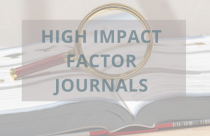Is There a Relationship Between Impact Factor and Rejection Rate?

Several elements come into play when deciding where a manuscript should be submitted for publication. Of course, the subject area of the study must fit into the scope of the journal under consideration; however, in addition to that, the impact factor, possibility of acceptance, and speed of decision seem to be important criteria for most authors. Impact factor plays a prominent role as many researchers—including members of institutional committees, who decide about funding, awards, and promotions—believe that studies published in high-impact-factor journals, which have very high rejection rates, have a significant impact in the subject area that is being studied. Also, having a paper published in a high impact factor journal is considered to be challenging, and thus those authors who get published in such journals can attract more funding and collaborations.
Relating Impact Factor and Rejection Rate
In 2015, the open access publisher Frontiers in a report stated that high rejection rates were observed from many journals that have low impact factors. For this report, the impact factors of 570 randomly selected journals that were indexed in the 2014 Journal Citation Report were obtained and plotted against their publicly stated rejection rates. Based on the data, there seemed to be “absolutely no correlation” between the two parameters. However, the figure provided in the report is not particularly informative. In fact, the names of the journals are missing and the criteria used to select these 570 publications from more than 8000 science journals and over 3000 social science journals indexed by JCR is not clear. Based on the report published by Frontiers, the blog quantixed has shared a separate analysis that has some names of the journals and impact factors listed out separately.
The primary problem in the report shared by Frontiers is the lack of relation in the data. In the report, the following issues were noticed:
- Journals from mathematics, statistics, and architecture, which usually do not attract that many citations, were compared with those from areas such as materials science, nanotechnology, or medicine.
- The report does not distinguish between languages (a journal published in English will most probably have a higher impact factor than a Portuguese or a German journal, which has a very small audience).
- The report does not distinguish between open access and subscription publications.
In response to the comments of scientists who carried out a similar study in 2008, finding a clear correlation between the impact factors and rejection rates of ecology publications with impact factors above 1.76—the authors of the Frontiers commentary decided to publish a second post in which they normalized the impact factors by field (arts and humanities, life sciences and biomedicine, physical sciences, social sciences, and technology). Nevertheless, comparing a catalysis publication with an astrophysics journal still does not make too much sense (although they both belong to the physical sciences). Besides, other factors, such as different languages or the publication of general reviews versus specialized research, are still not considered. More importantly, the sample only includes 5% of all the journals indexed by JCR.
Scope and Quality
So, although the rejection rates are very high for some journals, the reasons are usually quite simple: a) limited publication space, b) scope of the journal, and c) quality of the papers. The space issue is particularly true for top-ranking journals, which receive many more manuscripts than they can publish and therefore usually do have high rejection rates, but the scope and quality issues can also affect low-impact-factor journals. Just because a publication has a low impact factor, it does not have to publish all the manuscripts it receives. If some of them are not good enough or do not fit within the scope of the journal, the editors and/or referees might decide to reject them.
Understanding Impact Factor
Despite all the problems mentioned above, the report by Frontiers could be the starting point for interesting discussions. A study published in 2006 for radiology journals suggests that it could even be right in some cases. Although impact factors should not be used to decide promotions or funding because they do not reflect the quality of individual papers in a journal, but before drawing any general conclusions about the relationship between impact factors and rejection rates, a more complete and systematic study is required.










Thanks